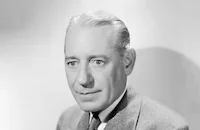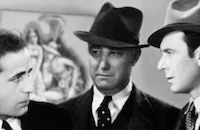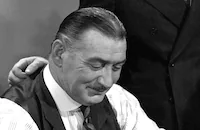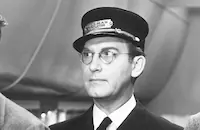Confessions of a Nazi Spy

Brief Synopsis
Cast & Crew
Anatole Litvak
Edward G. Robinson
Francis Lederer
George Sanders
Paul Lukas
Henry O'neill
Film Details
Technical Specs

Synopsis
In a small Scottish town in the late 1930's, Mrs. Mary MacLaughlin operates a secret international Nazi postal office out of her home. Her services are provided to agents working all over the world, including Kurt Schneider, an American soldier living in New York. Dr. Karl F. Kassell, a U.S. Navy Reserve officer, also works for the Nazis--he heads the New York German Bund and is devoted to the "purification" of the German race. Schneider's career as a spy begins with orders to report to the Nazis on the number of American troops stationed in the New York area. He carries this task out successfully, but complains when he is paid by the Nazis a meager monthly wage of fifty dollars. Meanwhile, at a New York Bund rally, Gestapo agents forcibly remove a dissenting voice from the meeting. Subversive Nazi activities are also taking place on board the German ocean liner Europa , where Franz Schlager is the ship's Nazi leader. Schlager works closely with the ship's beauty salon operator, Hilda Keinhauer, who reports passenger Anna Keller when she learns that Keller does not sympathize with the Nazi regime. Upon his arrival in New York, Schlager is instructed to make contact with Schneider and give him a new assignment. Impatient for better work, Schneider sends a letter to Nazi officials in Germany, but when the letter is intercepted in Scotland, Mrs. MacLaughlin is arrested. The evidence found in MacLaughlin's home prompts an F.B.I. investigation, led by Edward Renard, into Nazi espionage activities in the United States. Federal agents are soon tipped off to one of Schneider's assignments and arrest the Nazi operative. Schneider is brought to Renard for questioning, and Renard cleverly extracts a full confession from him. When Hilda Keinhauer, whom Schneider implicates, is arrested, she unintentionally implicates Kassell. Renard surprises Kassell at his office, and he, too, eventually cracks under pressure, naming others involved in the spy ring. A nationwide dragnet is ordered, and many more agents are arrested, including Hintze and Wildebrandt, who are later released. Although Renard tries to protect Kassell from Hintze and Wildebrandt, he is too late to prevent them from abducting him and forcing him to board the German liner S. S. Bismarck for Germany. Renard sends orders for the ship to stop and surrender Kassell, but the captain refuses to obey them. When the ship docks in Germany, the Gestapo orders Kassell to file formal charges of harassment and intimidation against the F.B.I. Meanwhile, Dr. Julius Gustav Krogman, a German government official, appears at Renard's office to advise Keinhauer to lie and say that she was forced to sign a false confession. Renard dismisses Krogman from his office, and realizes that the official's attempt to intercede on Keinhauer's behalf proves the German government's complicity in the espionage crimes. The spy case goes before a grand jury, and four of the major participants in the spy ring are convicted and sentenced.

Director

Anatole Litvak
Cast

Edward G. Robinson

Francis Lederer

George Sanders

Paul Lukas

Henry O'neill

Dorothy Tree

Lya Lys

Grace Stafford

James Stephenson
Celia Sibelius

Joe Sawyer

Sig Rumann
Lionel Royce
Henry Victor

Hans Von Twardowsky
John Voigt
Frederick Vogeding
Willy Kaufman
Robert Davis
William Vaughn
George Rosener
Frederick Burton

Eily Malyon
Bodil Rosing
Fred Tozere
Frank Mayo
Lucien Prival
Martin Kosleck

Ward Bond
Alec Craig

Jack Mower

Jean Brooks
Robert Emmett Keane
Charles Sherlock

Edward Keane
William Gould

John Hamilton
Selmer Jackson

Emmett Vogan

John Ridgely
Egon Brecher
Edwin Stanley
Niccolai Yoshkin
John Conte
Charles Trowbridge
Tommy Bupp
Ferdinand Schumann-heink
Crew
Milo Anderson
Claude E. Archer
Louis Baum
Bill Conger
Bob Cowan
John Deering
Mack Elliott
Frank Evans
Ruby Felker
Frank Flanagan
Leo F. Forbstein
H. Goldman
M. Goldman
Ernest Haller
Chuck Hansen
Frank Heacock
Milton Krims
Robert B. Lee
Cora Lobb
Robert Lord
Owen Marks
Jean Mcnaughton
Dick Moder
Harold Noyes
John Polito
Sol Polito
Joe Stinton
Ted Thomas
Leon G. Turrou
Jack L. Warner
John Wexley
Carl Jules Weyl

Photo Collections
Videos
Movie Clip



Trailer
Film Details
Technical Specs

Articles
Confessions of a Nazi Spy
In 1939 the US was still distracted by the last vestiges of the Great Depression. The war in Europe was a far off problem and irrelevant to most. But not to Jack and Harry Warner. Children of hard working immigrants, they had built a career on movies about the little guy, oppression, and fighting for freedom. For example, film biographies produced by Warner Brothers such as The Life of Emile Zola (1937) and Juarez (1939) can be interpreted as historical allegories with barely disguised references to anti-Semitism and totalitarianism. A case can even be made for costume dramas such as The Adventures of Robin Hood (1938) which can be seen as using the familiar storyline to address the dangers of dictatorial power and corrupt governments. Coincidentally, the first major film for Warner Brothers in 1918 was a propaganda action film, illustrating the build up to World War One entitled My Four Years in Germany. So, in 1939, when the first Jewish escapees from the Nazi concentration camps started telling their stories to the world, and when German thugs spray painted and ransacked the Warner offices in Berlin, murdering one of their employees, it made perfect sense that Jack and Harry Warner decided it was time to release Confessions of a Nazi Spy, regardless of being labeled warmongers and propagandists.
Despite personal threats against most of the principals of the film, Confessions of a Nazi Spy was courageously released in 1939, six months before the official beginning of the Second World War, and served its purpose of awakening a good deal of the American public to the dangers of Nazism. It stirred up enough controversy so that in 1941, after several protestations by isolationists, Nazi sympathizers and those fearful of losing business overseas with the "friendly" German nation, the brothers Warner were testifying before a Senate hearing - just two months before Pearl Harbor - investigating "moving picture propaganda" which fostered "war mongering." Harry Warner explained in his statement to the committee that the movie was not merely a work of fiction designed to build support for the war, but, "correctly portrayed the operation of a Nazi spy ring in this country, as this operation was disclosed at a Federal trial which convicted the conspirators." And, in fact, the film was based on a series of articles by former FBI agent Leon G. Turrou, depicting the spy case mentioned by Harry Warner. It also utilized a semi-documentary style showing spy ring activities in newsreel fashion and even showed some actual news clips from the 1937 trials of four Nazis convicted of espionage.
Although Edward G. Robinson said in his autobiography, All My Yesterdays, that because he and other members of the cast were so familiar to the viewing public that some of the documentary feel of the piece may have been better served by unknowns, it is obvious in retrospect that it would be impossible to think of anyone else but Robinson in the role of the cool and determined secret agent Renard. And as Schneider, an evil dupe of the Nazis, Francis Lederer was so convincing in his role that he was once asked in an interview whether or not people boo him whenever they see him in public. In fact, the scenes of Robinson interrogating Lederer are among the highlights of the film. Other standouts are the aforementioned Paul Lukas and the usually urbane George Sanders playing Schneider's boss, the cold-blooded Schlager. All of them are terrific and believable under the expert guidance of the well respected journeyman director, Anatole Litvak, a true anti-fascist who, throughout his career, had always been fascinated by the tarnishing of innocence.
Only a shocking event such as Pearl Harbor could drag us eventually into a war we didn't want, but maybe films like Confessions of a Nazi Spy helped contribute to an overall sense of the necessity to oppose fascism in any form. As Variety said in its 1939 review of the movie, "Decades from now what's happening may be seen in perspective. And the historians will certainly take note of this daring frank broadside from a picture company."
Producer: Robert Lord
Director: Anatole Litvak
Screenplay: Milton Krims, John Wexley, based on articles by Leon G. Turrou
Cinematography: Sol Polito
Film Editing: Owen Marks
Original Music: Max Stiener
Principal Cast: Edward G. Robinson (Ed Renard), Francis Lederer (Schneider), George Sanders (Schlager), Paul Lukas (Dr. Kassell), Henry O'Neill (Attorney Kellogg), Dorothy Tree (Hilda Keinhauer), Sig Ruman (Krogman), James Stephenson (British Military Intelligence Agent).
BW-105m. Closed captioning.
by Joseph D'Onofrio

Confessions of a Nazi Spy
Quotes
Trivia
Hitler reportedly planned to execute the makers of this film upon winning the war.
This was the first anti-Nazi movie made in Hollywood before the start of World War II.
The movie is based on an actual spy-ring trial in New York in 1938, which convicted four individuals of spying for the German government.
Some well-known actors (including Anna Sten and Marlene Dietrich) refused to be in the movie fearing reprisals against relatives living in Europe. Many who did appear changed their names for the same reason, accounting for large number of aka's in the cast list.
Warner Bros. increased security throughout the production and some actors slept on the Warners lot. Sabotage was suspected when a boom holding one of the cameras collapsed, narrowly missing director Anatole Litvak.
Notes
Actress Eily Malyon's name is misspelled as "Ely Malyon" in the opening credits. The working title of this film was Storm over America. Contemporary sources indicate that this film, presented in a semi-documentary form, was the first of the anti-Hitler films made in Hollywood before the start of World War II. Much of the film was based on a highly publicized German spy trial that took place in New York in 1938. In late October 1938, according to a Hollywood Reporter news item, Warner Bros. sent contract writer Milton Krims to New York to cover the trial of eighteen individuals charged with spying for the German government. The trial took place between 29 November and December 2, 1938 and resulted in the conviction of four individuals (fourteen of the accused spies were still at large). Producer Harry Warner's involvement in anti-Nazi activities was widely known in Hollywood in the late 1930s, as was that of star Edward G. Robinson, who, according to a late 1938 Hollywood Reporter news item, was affiliated with a group called the "Hollywood Anti-Nazi League for the Defense of American Democracy."
According to the file for the film in the MPAA/PCA Collection at the AMPAS Library, soon after Warner Bros. expressed interest in the spy trial, the Charge d'Affairs of the German Counsel in Los Angeles sent a letter to the PCA requesting that it prevent the studio from producing the picture. The PCA also received a letter of protest from an official at the Paramount Foreign Department in New York, who voiced his opposition to Warners' plan to make an anti-Nazi film, calling it a "big mistake." The Paramount official accused Warners of ignoring the example set by Charlie Chaplin, who had, he claimed, decided that a picture burlesquing Adolf Hitler would be too dangerous to film. He also warned that if the picture were made, Warners would have "on their hands the blood of a great many Jews in Germany."
Ignoring the opposition to the script, Warner Bros. went ahead with the picture, and on December 6, 1938, a Hollywood Reporter article announced that the studio was rushing production on the film to meet a targeted January 15, 1939 release date. Although the casting was not yet completed, the production on the Krims script was set to begin (on a twenty-four hour basis) the following day. The article also stated that the cast would be made up entirely of unknown actors-all non-Aryans. Krims's script was reportedly polished aboard a Hollywood-bound train by Krims and producers Jack Warner and Hal Wallis. The first draft of the script was submitted to the PCA by late December 1938, at which time the PCA informed Warner Bros. that although the screenplay appeared to be "technically" within the provisions of the Production Code, because of its controversial nature it could be rejected by censor boards fearing that the exhibition of the film would result in public disorder or incite a riot.
The PCA file also contains a series of "notes and observations" on the story by PCA official Karl Lischka, who wrote on January 22, 1939 that the story was in violation of the Code because "Hitler and his government are unfairly represented." Lischka took issue with the story's portrayal of Hitler as a "screaming madman and a bloodthirsty persecutor," and instead praised the German leader's "phenomenal public career and his unchallenged political and social achievements." Lischka said that the story's inference that the German government was a direct sponsor of agitation in the United States constituted a "grave accusation which lacks proof." He also criticized "extraneous" elements of the story, including the abolition of Christian schools and the dismemberment of Czechoslovakia. Lischka concluded that if the film were made it would be "one of the most lamentable mistakes ever made by the industry."
Although Warner Bros. planned to start production on the picture in early December 1938, filming did not begin until February 1, 1939. In early January 1939, Leon G. Turrou, the U. S. government agent who broke the spy ring, was hired by Warner Bros. as a technical adviser. According to modern sources, the publication of Turrou's articles on the Nazi spy trials in New York were delayed for five months, following the issuance of a June 1938 restraining order blocking their publication. A contemporary news item notes that Turrou quit his job at the F.B.I. just prior to selling his article on the spy trial to the New York Post. Turrou also wrote a book on the case, entitled Nazi Spies in America, which was published in New York in 1939, and which he sold to Warner Bros. for $25,000.
A Hollywood Reporter pre-production article notes that because the studio encountered casting difficulties in Hollywood, director Anatole Litvak traveled to the East Coast to cast many of the parts. A number of Hollywood actors reportedly refused parts in the picture because they feared that their participation in the film would result in reprisals by the Nazis against their relatives in Germany. Anna Sten and Marlene Dietrich were among those originally announced for leading feminine roles.
Warner Bros. publicity material on the film notes that because the subject matter of the picture was considered to be highly controversial, extreme precautions were taken to insure the safety of those working on the production. Four uniformed studio policemen were posted near the sound stage to bar the press and anyone else not directly involved in the film, including Warner Bros. executives, from the set. To insure the secrecy of the script, only ten copies of it were mimeographed (as opposed to the usual 150 copies made for a production of this size), and most of the actors got their lines one day at a time. More than a dozen people associated with the film took up residence on the Warner Bros. lot and lived there throughout the production. Despite the heavy security, sabotage was suspected on the set when a boom holding one of the cameras collapsed and narrowly missed hitting director Anatole Litvak. The publicity material also notes that after the first ten principal players were chosen for the picture, Warner Bros. decided to remain silent about further casting news and announced that subsequent cast additions would be referred to by numbers instead of names.
Warner Bros., in fact, went to great lengths to conceal the identity of those actors who wished to remain anonymous. Not only did the actors receive fictitious names, such as Celia Sibelius, Robert Davis and John Voigt, but makeup artists had the actors so heavily made up that, according to Warner Bros. publicists, "even their best friends won't recognize them on the screen." However, employment contracts in the Warner Bros. production file reveal the true identities of the actors: "Robert Davis" was actually Rudolf Amendt; "John Voigt" was Wolfgang Zilzer and "Celia Sibelius" was Hedwiga Reicher. "Jean Brooks," who was credited as "Kassell's nurse," May have been actress Lotte Palfi, who tested for the role on February 8, 1939, or Louise Golm. The production file also indicates that Hans von Morhart was originally contracted for the part of "Kranz." Although their appearance in the released film has not been confirmed, studio records of the daily production activity on the film indicate that following actors were scheduled to appear in the film: Tempe Pigott, Ray Miller, Ed Meski, John Harron, Walter Bonn, Dave Wengren, Lester Scharff, George Offerman, Fred Graham, Stan Pomeroy, Jack Storey, Frederick Jehrman, Rudolph Steinbeck, Sherwood Bailey and Walter Moore.
Pre-release news items in Hollywood Reporter and New York Times note that set designer Carl Jules Weyl designed eighty-three sets for the film (breaking all previous records for the number of sets on a Warner Bros.' film), that cameraman Ernest Haller took over the photography of the film when Sol Polito fell ill, and that the film was budgeted at $1,500,000. Studio publicity records indicate that Warner Bros. dance director Bill O'Donnell was put in charge of preparing 350 bit players for the Bund camp military sequence.
In May 1939, according to news items in Hollywood Reporter, German-American Bund leader Fritz J. Kuhn tried to block the release of the film by filing a $5,000,000 libel suit against Warner Bros., and requested a temporary injunction against the film's exhibitors. A federal judge denied Kuhn's request for an injunction, and after failing to win an appeal, Kuhn was instructed by the judge (at Warner Bros.' request) to answer specific questions in reference to the history and constitution of the Bund, in addition to naming the characters in the film who he claimed represent himself and other Bund members. In September 1939, Hollywood Reporter noted that Warner Bros. filed a legal answer to Kuhn's suit, in which the studio requested a jury trial to hear its proof that the Bund was an "active militant propaganda agency" of the German government, and that its members were "abusing the rights and privileges of American citizens." Modern sources note that Kuhn's suit was dropped following charges that he embezzled Bund funds. Kuhn's suit coincided with a similar one filed by one of the convicted spies, Katherine Moog (who was portrayed by Lya Lys in the film), in July 1939. Moog, also known as Katherine Moog Busch, eventually lost her $75,000 suit, in which she claimed that the portrayal of herself as the character of "Erika Wolf" constituted libel. Modern sources note that although an early draft of the screenplay used the actual names of the defendants in the New York spy case, the name of the character portraying Moog was always referred to as "Erika Wolf." Moog's identity was allegedly concealed from the outset because of her ties to high-ranking U. S. government officials.
The film did record-breaking box office business around the world and was re-released in 1940 with a new ending that included footage showing the effects of the Nazi occupation of Norway, Holland and Belgium. Confessions of a Nazi Spy was banned in Japan and eighteen Latin American and European nations, including Ireland, Italy, Denmark, Norway, Argentina, Costa Rica, Sweden, Belgium and Brazil. Hollywood Reporter notes that in an attempt to reverse Brazil's decision to ban the film, Harry Warner personally cabled the Brazilian government and offered to turn over all of the film's Brazilian receipts to the Red Cross. Germany reacted with expected outrage at the film, and issued an official warning to the Hollywood film community that it would ban all future films that used cast or crew members employed in the film. According to an Los Angeles Examiner article, the U.S. State Department was notified that German Propaganda Minister Joseph Goebbels had ordered the Nazi-run German film industry to produce a series of "documentary" films bearing upon American unemployment, gangsterism and judicial corruption in retaliation for Warner Bros.' release of Confessions of a Nazi Spy.
Following the release of the film, many instances of vandalism and threats were reported by theater owners, and one news item told of seven theater operators who screened the film in Warsaw and reportedly were hanged following the German occupation. In addition, an August 1939 Hollywood Reporter news item noted that five Danzig citizens were arrested by Nazi authorities for having traveled to Gdynia, Poland, to see the film. Reported incidents of lesser seriousness ranged from the mysterious disappearance of three prints of the film from a Swiss War Department truck in Berne, Switzerland, as reported in Hollywood Reporter, to the vandalism done to a print of a Warner Bros. western that was mistaken for Confessions of a Nazi Spy during a break-in at a Hobbs, New Mexico, theater. In his autobiography, Jack Warner wrote that the film probably put him on Adolf Hitler's personal death list.
In September 1941, the New York Times reported that Harry Warner was called to testify before the Senate subcommittee hearings into alleged war propaganda in Hollywood films. Four Warner Bros. films, including Confessions of a Nazi Spy, were named as "propaganda films" in a resolution co-authored by Senator Gerald P. Nye. Harry Warner testified that the picture was "factual," and that Senator Nye had personally endorsed the film after attending a private screening of it in May 1939. Director Anatole Litvak was also subpoenaed to appear before the investigating committee.
Confessions of a Nazi Spy was selected as one of the best films of 1939 by the National Board of Review.















